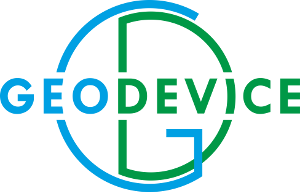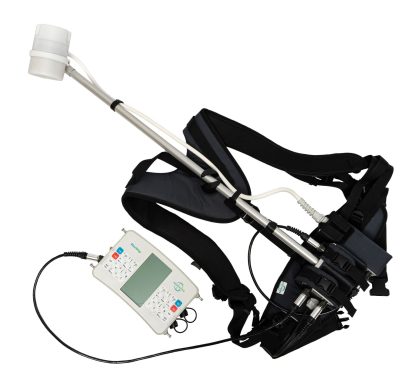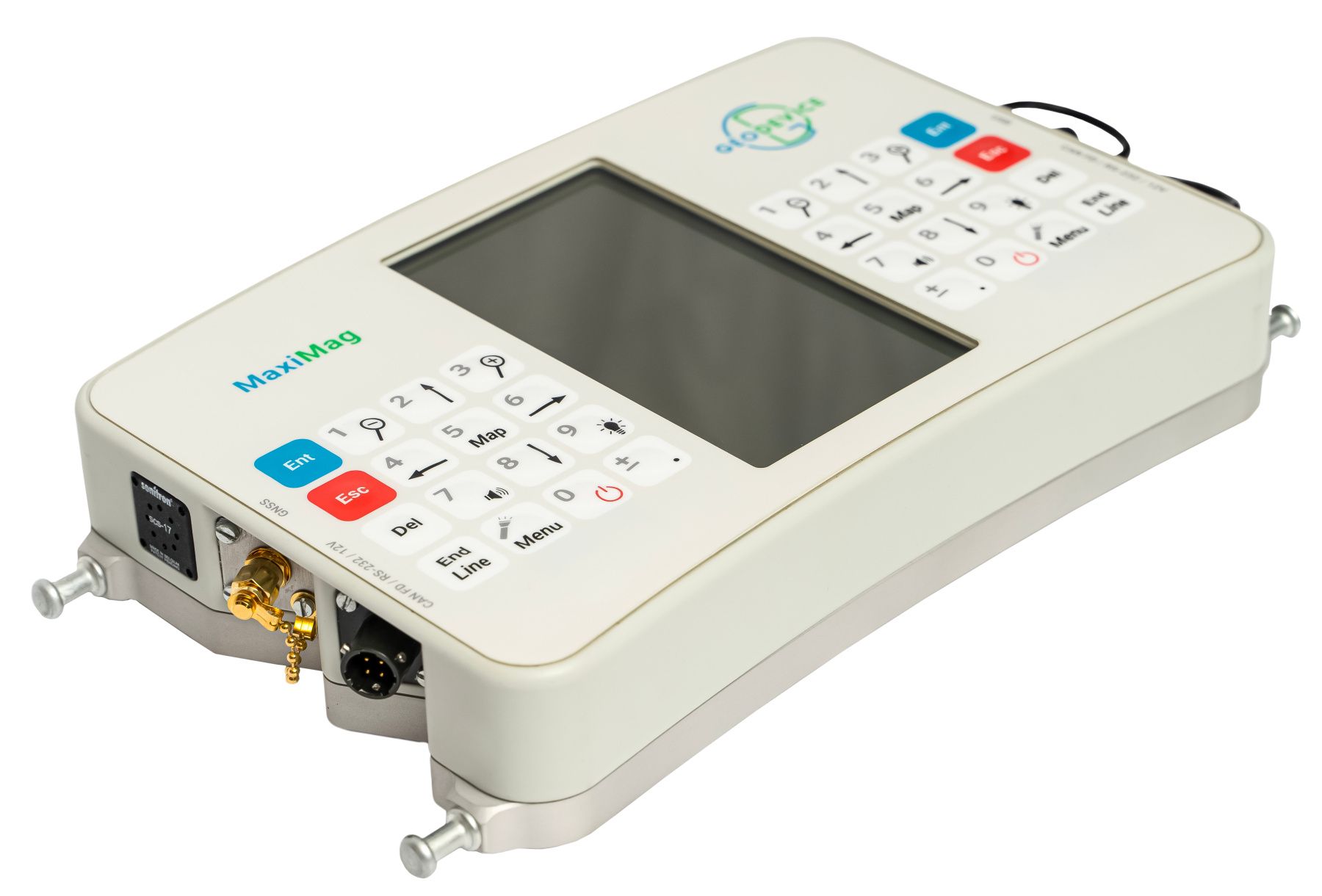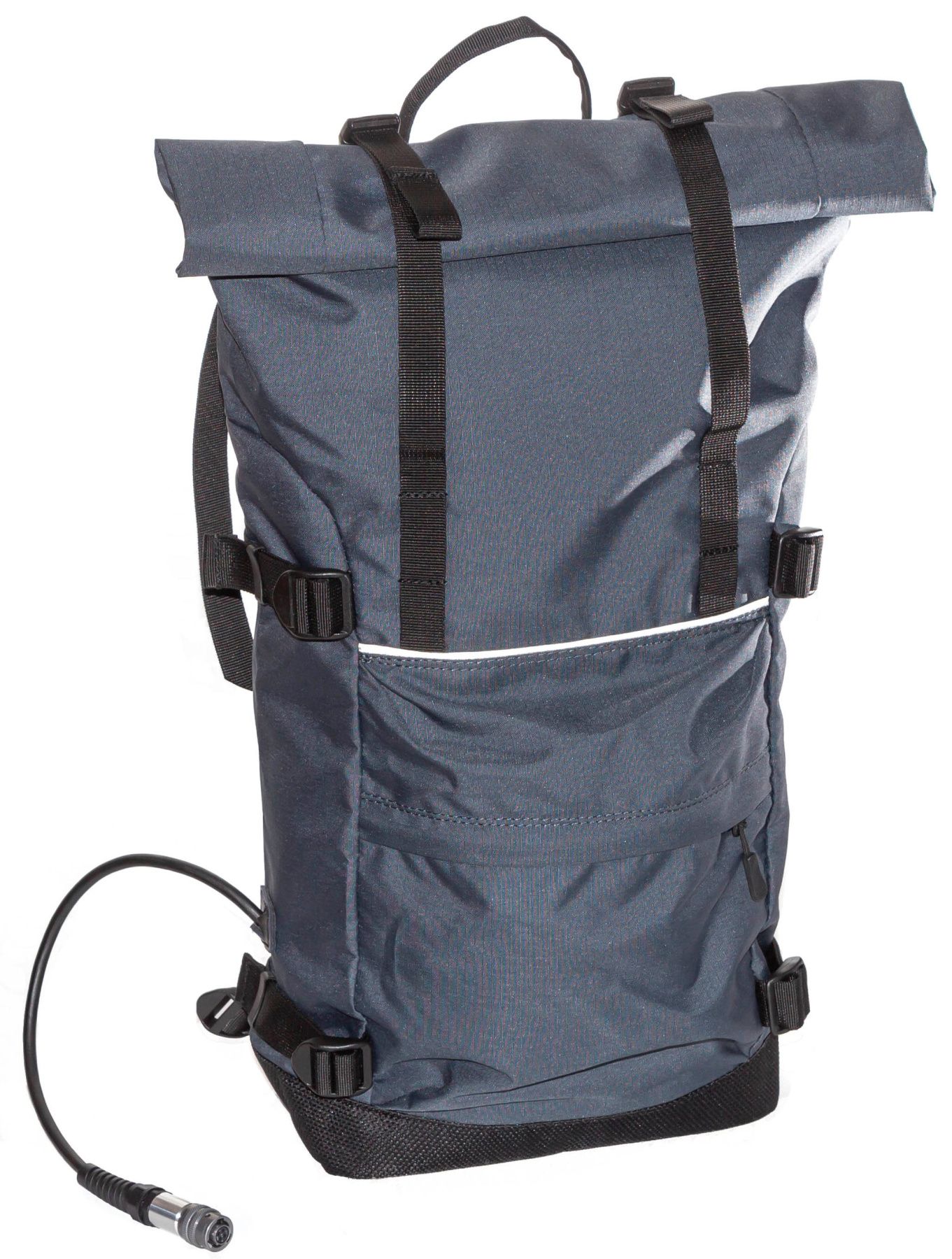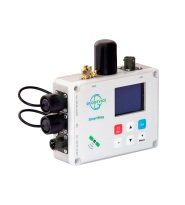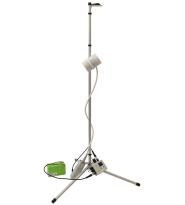Cesium walking magnetometer-gradiometer QuantumMag
QuantumMag is one of the most advanced and lightweight walking Cesium magnetometers on the market. The system allows to measure the Earth’s total magnetic field with highest sensitivity and sample rate up to 100 Hz. The device can be used as a walking magnetometer, gradiometer, base station, or even as a GNSS base and rover with centimeter accuracy in PPK mode. Console can be connected to a SmartQuantumMag magnetometer and recognizes it as a compatible digital sensor, so together they can be used as a walking magnetometer and a base station or as a gradiometer.
Perfect mobile magnetometer or gradiometer for any task
MaxiMag console permits connecting up to 6 digital Cesium magnetometers via a wired CAN interface. This unique feature enables building two- or multi-sensor gradiometers with the required measurement base and use any console-to-sensor distance.
Optional brackets and frames for any scenarios:
- Brackets for two sensors for carrying them in hand or in a backpack harness
- Versatile multi-sensor frame for cross-country and shallow water archaeological surveys
- Cart for multi-sensor gradiometer
- Sled for magnetometer and multi-sensor gradiometer
Easy-to-use tablet console
We have equipped the console with large daylight readable and heated display, two-way keypad, modern wired interfaces and even a flashlight. The control of measured values and their quality is provided in digital, graphical, and audible modes. Line planning, operator guidance, saving of coordinates and exact times of measurements are provided by built-in multi-band GNSS receiver.
In some cases, external GNSS receiver is required - MaxiMag supports the standard NMEA-0183 protocol and can be connected to most navigation devices. Data download is available via USB, RS-232 or from the built-in industrial microSD card. We also made sure that all our parts and connectors were non-magnetic, which allowed to reduce the dimensions of the ready-to-go magnetometer set. Maneuvering with a magnetometer in forests and jungles has never been easier!
UXO and utility detection
QuantumMag can be used as a deep metal detector and utility locator due to its high sample rate and graphics on display. This makes it perfect for the deep unexploited ordnance (UXO) detection and geotechnical studies.
Sensor can be carried in the backpack harness (regular survey) or at the shoulder belt (e.g. for UXO and utility detection) depending on the selected survey technique.
Magnetometer parts and backpack harness
The magnetometer package contains on one hand a minimum of unified parts to ease the assembly and use, and on the other - all necessary components, so that you do not have to buy additional cables, a battery, or GNSS receiver without which you will not be able to work. Every magnetometer we ship is ready to use in its basic configuration. Options add functionality, but are not required by most users for standard operating scenarios.
We have also designed an exceptionally comfortable and lightweight harness with plenty add-ons to fit anybody. The duffel bag can be unzipped or used to carry an additional battery, clothing or lunch.
Power supply
QuantumMag operates over 8 hours of continuous measurements at -30°C from the battery included. At 20°C, the operating time increases to 17 hours. Continuous power supply in long term monitoring mode can be provided with a car battery, an optional low-noise power converter from 110/220VAC to 12VDC, or a solar panel.
Included LiFePo4 battery has the full temperature range from -40 up to +60°C and MSDS certificate for any kind of transportation.
QuantumMag does not contain built-in batteries, which might complicate air transportation and sooner or later fail and require complex replacement.
Data format
User can create project folders that can be used to divide survey sites or data collection days. All measurements are saved in a TXT file in the project folder. The file from each magnetometer has a name containing the serial number of the console, the code of the measurement mode and the number of connected sensors. The files have a homogeneous structure, i.e. each measurement in the file is a line that contains all necessary information: UTC date and time, time zone, base name or line and station name, measured field, estimated error, sensor serial number, latitude and longitude in decimal degrees, altitude, UTM coordinates with automatic zone and hemisphere selection, horizontal and vertical accuracy. When working with a gradiometer, the line will contain measured field, estimated error, and sensor serial number for each of the connected sensors, and the file name will be different from the magnetometer mode, so the uniformity of the format will not be broken.
Even if there are many operators working on a survey site at the same time, you will always be able to identify which instrument was used for each single measurement in the database.
Metrology and noise protection - a guarantee of high accuracy
Every Cesium QuantumMag sensor is metrologically tested. We control the standard deviation of random error (noise), absolute accuracy and heading error.
The robust algorithms allow performing measurements at high level of industrial noise, in a city environment, or right under high-voltage powerlines.
Reliability and warranty
Our R&D specialists have extensive experience in performing geophysical surveys. We are well aware that such equipment must be reliable, and the service must be fast and comfortable. We give 3 years warranty on all our magnetometers, and our technical support will promptly answer any of your questions. You can also take advantage of our trade-in program and replace your old instruments with the new MaxiMag with discounts.
Built-in multi-band GNSS receiver with centimeter level accuracy
Time and coordinates are provided by the built-in multi-band GNSS receiver with PPK feature, which permits to achieve a centimeter level accuracy. Stored RAW GNSS data could be easely converted to RINEX format.
The console has GNSS receiver mode and can be used as a GNSS base, rover or tracker without mag sensor connected.
MaxiMag has built-in GNSS antenna and a connector for an external one. It also supports NMEA-0183 protocol and can be connected to external navigation devices via RS-232.
Important "little things"- Carry-on size transportation case with whole equipment setup weight 9 kg only
- Two-way keypad for both right- and left-handed people
- Ultra-bright LED flashlight for safe navigation in the dark
- Superior noise protection allows operation even under power lines
- More than 8 hours of continuous operation at -30°C and 17 hours at 20°C using the battery included
- Power cable for standard lead-acid battery included
- Mobile survey with walking or towed style and station measurements with line guidance
- Base station with continuous measurements
- Search mode for UXO objects detection or evaluation of a base station location
- GNSS receiver mode with ability to collect RAW GNSS data for a centimeter level accuracy with base or rover modes
- Mineral exploration
- UXO detection
- Regional geological surveys
- Engineering surveys
- Pipeline mapping
- Archaeological studies
- Oil and gas exploration
- MaxiMag console with built-in multi-band GNSS receiver
- CMx sensor on rod
- Sensor electronics QuantumMag
- Counter QuantumMag
- Lithium battery with charger
- Sensor-to-console cable
- Battery power cable
- USB cable
- Non-magnetic rod
- Backpack harness
- Transportation case
- MaxiMag console with built-in multi-band GNSS receiver
- CMx sensor on rod (2 pcs)
- Sensor electronics QuantmMag (2 pcs)
- Counter QuantumMag (2 pcs.)
- Gradiometer accessories
- Lithium battery (2 pcs) with charger
- Sensor-to-console cable
- Battery power cable
- USB cable
- Non-magnetic rod (2 pcs.)
- Backpack harness
- Transportation case
- SmartQuantumMag base station
- Additional digital CMx sensors
- Gradiometer accessories
- Non-magnetic cart for multi-sensor gradiometer
- Non-magnetic tripod
- External GNSS antenna on rod
- CAN-Ethernet interface unit for connecting to PC/router
- RS-232 cable for real-time data broadcasting
- SmartManager software
- Power supply 100-240 VAC
Magnetometry survey forward modelling and data inversion may be successfully performed with advanced ZondGM2d and ZondGM3d software packages.
|
Type |
Optical pumped Cs magnetometer |
|
Number of sensors |
up to 6 |
|
Dynamic range |
15 000 to 110 000 nT |
|
Absolute accuracy |
2 nT |
|
Sensor sensitivity |
0.002 nT/√Hz rms |
|
Resolution |
0.001 nT |
|
Gradient tolerance |
20 000 nT/m |
|
Sample rates |
up to 100 Hz |
|
Additional sensors |
IMU, compass |
|
Interfaces |
built-in: USB, RS-232, CAN FD. |
|
Maximum communication cable length |
up to 6 km (CAN FD), up to 100 m (RS-232) |
|
GNSS receiver |
built-in and optional external |
|
GNSS antenna |
built-in and optional external |
|
GNSS signals |
GPS L1C/A and L2C; GLONASS L1OF and L2OF; Galileo E1B/C and E5b; BeiDou B1I and B2I; QZSS L1C/A, L1S and L2C. SBAS: WAAS, EGNOS, MSAS, GAGAN |
|
Connectors |
2 × CAN FD+12V / RS232+12V, USB, external GNSS antenna |
|
Display |
240 × 128, LCD with heater |
|
Keypad |
32 buttons |
|
Built-in memory |
up to 32 Gb (microSD) |
|
Power supply |
9.5-21 VDC, LiPo 3S/4S, Li-ion 3S/4S, LiFePo4 4S, or lead-acid battery |
|
Operating temperature |
–40 to +60 °C |
|
Battery included |
12.8 V, 7.5 A·h |
|
Flashlight |
LED, 300 lumens |
|
Dimensions with connectors |
Ø82×120 mm – CMx sensor |
|
Item weight |
1.1 kg – console |
|
Weight of a set includes console, sensor, battery, harness and sensor cable |
4.8 kg – magnetometer |
|
Delivery package size and weight |
55.8 × 35.5 × 19 cm, 8.5 kg – magnetometer 62.5 × 50 × 29.7 cm, 18 kg – gradiometer |
| Delivery package size and weight | 62.9 × 39.3 × 20.9, 9 kg |
